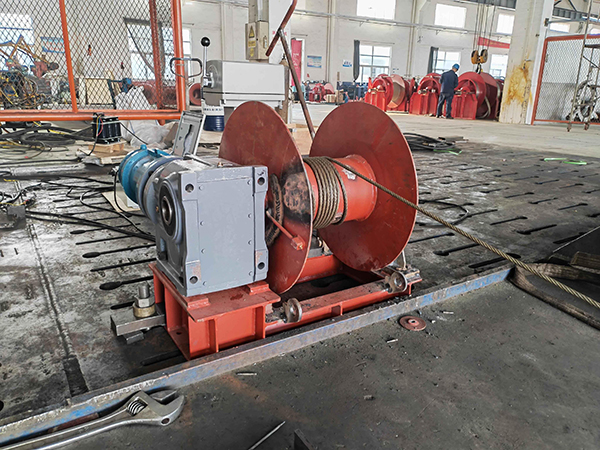CCS Type Test for Marine Mooring Winches
The following test requirements are based on CCS standards:
Type test
1 Selection of typical samples
When applying for approval, a representative set is to be selected from each series of winches according to the type to be approved, reflecting the design/production ability of the manufacturer.
Usually the winches with the maximum holding load are to be selected.
2 The type test items generally are to include the following:
(1) no-load operating test of the whole set;
(2) load test;
(3) test of the automatic braking system;
(4) test of holding load of brake;
(5) recovery load (applicable to automatic mooring winches only) (i.e. automatic constant tension test);
(6) rendering load (applicable to automatic mooring winches only) (i.e. automatic constant tension test);
(7) operational test of brake;
(8) dismantling.
3 Tests are to comply with the following requirements:
(1) CCS Surveyor is to check the manufacturer’s test laboratory/test bench used as approval test location and confirm compliance with the requirements of 8.3(2). Otherwise, all tests are to be carried out at certification and test organizations recognized by CCS.
(2) Measuring instruments used in the tests are to have valid calibration certificates, and the accuracy of test instruments is not to be lower than that required by Table 3(2).
|
Accuracy of Test Instrument Table 3(2) |
|
|
Items to be measured |
Allowable system error of test instrument (%) |
|
Pressure |
±1.5 |
|
Flow |
±2.5 |
|
Temperature |
±2.5 |
|
Stopwatch |
±1 |
4 Test methods are to comply with the following requirements separately.
(1) No-load operating test of the whole set: The clutch is to be turned on and the brake loosened to operate the mooring winch continuously for 15 min respectively in both directions at no-load speed.
(2) Load test: With the drum load as applied load, the applied weight is to be raised and lowered continuously for 30 min at the nominal speed, within an effective height of about 8 m.
(3) Test of the automatic braking system:
① the test is to be carried out in the test conditions of load test. The automatic braking system is to stop the drum rotation without failure. When the operating device of an electric mooring winch is brought to the braking or stop position, the automatic braking system is to brake immediately;
② when the applied weight (equal to drum load) is raised, the weight is to be increased to 1.25 times the weight of drum load, without slip or damage of the automatic braking system of the electric mooring winch. For hydraulic mooring winches, certain slip movement not exceeding 1 m in one minute is allowed.
(4) Test of holding load of brake: The drum braking device is to be turned on to prevent reeling of it, and the static load test is to be carried out by applying the holding load on the steel wire led out from the drum.The drum shall not rotate within 2 min .
① if the design brakes is mature and complies with the design calculation and strength requirements of 7.1.2 of this Guideline, the test may be dispensed with. For novel designs, however, the test is to be carried out;
② there is to be no slip of the brake in the test and no permanent deformation of parts under force after the test.
(5) Recovery load (applicable to automatic mooring winches only) (i.e. automatic constant tension test): The maximum applied weight which can be raised by the drum is to berecorded when the drum commences to rotate in the haul direction, with the prime mover being set for the maximum torque under automatic control and the rope being wound on the drum in a single layer.
(6) Rendering load (applicable to automatic mooring winches only) (i.e. automatic constant tension test): The maximum applied weight which can be raised by the drum is to be recorded when the drum just commences to rotate in the direction opposite to the applied driving torque, with the prime mover being set for the maximum torque in automatic control and the rope being wound on the drum in a single layer.
(7) Operational test of brake: The brake is to be operated tightly, the clutch disengaged and a load 1.5 times the drum load applied on the drum, without slip of the brake.
(8) The winch is to be dismantled and examined after the above tests.


 Tel:+86-23-67956606
Tel:+86-23-67956606 Email:
Email:
